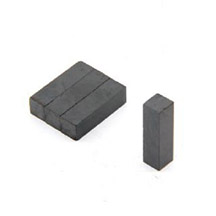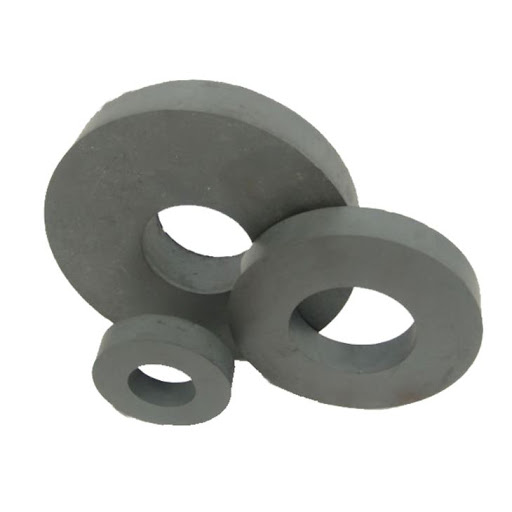Since ferrite and ceramic magnets are usually referred to as some of the strongest and most durable magnets that exist in the world, I wanted to find out how strong these types of magnets really are. So, I did some of my own research and testing to find out the real strength of ferrite and ceramic magnets.
- Ferrite Magnet Supplier
- Ferrite Magnet Grades
- Ferrite Magnet Gauss
- Ferrite Magnetization
- Ferrite Magnet Ball
- Ferrite Ring Magnets
How strong are ferrite and ceramic magnets? The strength of ferrite and ceramic magnet is measured through a unit called a Tesla. The strongest magnetic field of a ferrite magnet is considered to be 0.35 Tesla. A ferrite magnet is able to complete within its magnetic field is up to 160 kiloampere tpm, or up to 2000 oersteds.
Ferrite and ceramic magnets are considered to be permanent magnets, which are among the strongest and most durable magnets that exist in the world. When it comes to the magnetic force of these types of magnets, they are calculated through specific units of measurement and translate to very high amounts.
Ceramic Ferrite magnet is one of the most cost-effective magnetic materials. It has a fair to good resistance toward corrosion and it can operate in moderate heat. Ceramic Ferrite magnets are low energy products and they are usually used in assemblies containing mild steel. Ferrite magnets grades & magnetic characteristics. Ferrite magnets are brittle and therefore should not be used where mechanical stress is applied on the magnets. Ferrite magnets can be used in relatively high temperatures. Here are some typical thermal properties of ferrite magnets: Reversible temperature coefficient of residual induction -0.2. Hard ferrite magnets with 3S (super-small, super-big and super-thin) structure are also producible by wet molding process. The dimensional deviation of hard ferrite magnet is controlled within +/-2% before being machined, and could be controlled within +/-0.10mm after being simply ground by diamond tool.
Today we will be going over how strong ferrite and ceramic magnets really are, in terms of Tesla and turns per meter, or oersteds. Keep reading to find out everything you need to know in order to become a magnet strength expert by the time you get to the last page.
- Ceramic (ferrite) magnets are sintered permanent magnets, composed of Barium or Strontium Ferrite. Aside from good resistance to demagnetization, ceramic magnets are very low cost and ideal for a wide variety of applications. Sizes & Shapes: Common stock sizes range from 0.250' to blocks that measure up to 10' on one dimension.
- For many years, all magnets have been natural magnets, such as lodestone, which is a kind of iron ore with magnetic properties. In 1952, magnets were first made of ferrite. By making magnets from ferrites, engineers can make magnets in any shape they want. By making the carefully manufactured mixture into ferrite magnets, a.
How Strong Are Ferrite & Ceramic Magnets?
You might already be aware that ferrite and ceramic magnets, a type of permanent magnet, have the capability to exhibit very high levels of strength. However, most people cannot say that they know exactly how strong one of these magnets are.
Ferrite & Ceramic Magnets Average Strength:
- 0.35 Tesla
- 30-160 Kiloampere
- 400 to 2000 oersteds
The strength of ferrite or ceramic magnet, in particular, is measured in a unit called Tesla. Teslas account for one weber per square meter within a magnetic field, which is equal to 10,000 gausses.
The average strength of a ferrite magnet is around 0.35 Tesla, with the strongest and most powerful medical MRI machine coming in at just 3 teslas, to give you a better idea of where these magnets stand.
The magnets’ strength is also measured bt the turns per meter that they are able to produce in terms of their magnetic fields. On average, a ferrite magnet will exhibit around 30 turns per meter, with the highest being 160.
Turns per minute is referred to scientifically as a kiloampere. The average statistics of 30 to 160 kiloampere translate to anywhere from 400 to 2000 oersteds.
Just one oersted is the equivalent to just under 80 amperes per meter, which is a relatively high number when it comes to magnetism.
Although these new terms of measurement might seem like a foreign language no matter how well they are explained, the next section will go over how ferrite magnets can be compared to other types of magnets that you might have heard of before.
Ferrite & Ceramic Magnets - Strength Comparison
Along with learning about the strength levels and capabilities of ferrite and ceramic magnets, it is helpful to be able to observe a direct comparison between these types of magnets and other categories.

Whether you have any previous knowledge of magnetism and the strength of some of the most basic types of magnets or if you are looking to learn about these topics, the list down below will give you a general explanation of where ferrite and ceramic magnets fall on the spectrum of strength.
How The Strength Of Ferrite & Ceramic Magnets Compares To Others:
- Stronger than metallic magnets
- Weaker than neodymium magnets
Due to the high level of magnetic permeability that ferrite and ceramic magnets possess naturally, they are able to give off stronger magnetic fields than most types of metallic magnets.
To be more specific, permeability is defined as the influence that a substance has on the magnetic fields that are existent in that specific area. So, ferrite and ceramic magnets are significantly stronger than magnets in the metallic category.
On the contrary, ferrite magnets are much weaker than neodymium magnets. This is because neodymium is one of the strongest magnetic materials in existence.
Neodymium magnets can be used within households as well as in industrial and commercial settings, with various different sizes and purposes. Most commonly found in the form of a disc magnet, neodymium magnets are widely used around the world on a daily basis.

To give you a better idea of how strong ferrite and ceramic magnets really are when they are up against their counterparts, they are stronger than metallic magnets but weaker than neodymium magnets, which puts them somewhere in the middle.
What Are Ferrite & Ceramic Magnets?
Ferrite magnets, also known as ceramic magnets, are a type of magnet that is made out of a mixture of metals that is called ferrite.
Ferrite Magnet Supplier
Ferrite is made up mostly of a chemical element called iron oxide. More specifically, ferrite magnets are made up of 90 percent iron oxide, along with traces of other types of metals and elements to make up the remaining 10 percent.
The most widely manufactured and distributed type of ferrite magnet is called Strontium Ferrite, or SrO6(Fe2O3). In the list down below, you will find a short description of what this type of ferrite magnet is made out of.
Ferrite Magnet Grades

What Ferrite Magnets Are Made Of:
- Chemical Compound Ferrite
- Chemical Composition SrO6(Fe2O3)
- 90 percent iron oxide
- 10 percent strontium carbonate
Along with the Strontium Ferrite magnets, there is an additional type of ferrite and ceramic magnet. Also made up mostly of the chemical element iron oxide, the rest of this type of magnet is made of Barium.
Also known as Barium Ferrite, or BaO.6Fe2O3, it is the least popular option when it comes to ferrite and ceramic magnets.
So, what are the actual characteristics of Strontium and Barium Ferrite magnets, and what makes them different from any other category of magnet?
What Are Ferrite Magnets?
- Made of iron oxide
- Combined with other chemical elements
- 2 types of ferrite magnets
- Resistant to demagnetization
- Strong and durable
- Weaker than neodymium magnets
- Difficult to alter
Ferrite magnets are made up of a large mixture of iron oxide and various other chemical elements. Both of the categories that were mentioned above are extremely strong and durable, while still coming in weaker than neodymium magnets.
These types of permanent magnets are very difficult to alter, while not impossible. With the consolation of a professional as well as very careful technique, a ferrite magnet can be cut into and the shape can be changed accordingly.
Additionally, there is always the option to purchase a custom made ferrite magnet that takes the shape of exactly what you need it for, which is the most preferable choice.
As you can see, ferrite and ceramic magnets have very unique properties of their own and are very strong when it comes to the magnetic fields they give off.
Their exact strength can be measured and compared to other types of magnets to help us come to the conclusion that these durable magnets can be used to our advantage for almost anything.
Ferrite Magnet Gauss
Ferrite magnet: Its main raw materials include BaFe12O19 and SrFe12O19. Manufactured by ceramic technology, the texture of ferrite magnet is relatively hard and it is a brittle material. Due to the good temperature resistance, low price and moderate performance of ferrite magnet, ferrite magnet has become the most widely used permanent magnet.
Ferrite magnet is a sintered permanent magnet material composed of barium and strontium ferrite. In addition to strong anti-demagnetization performance, this kind of magnetic material also has the advantage of low cost. Ferrite magnets are hard and brittle, and require special machining processes. The opposite magnet is oriented along the manufacturing direction and must be magnetized in the direction taken, while the same magnet can be magnetized in any direction because it has no orientation, although a slightly stronger magnetic induction is often found on the side where the pressure is the smallest. The magnetic energy product ranges from 1.1MGOe to 4.0MGOe. Due to its low cost, ferrite magnets have a wide range of applications, from motors and speakers to toys and handicrafts, so they are currently the most widely used permanent magnet materials.
Ferrite magnet is divided into permanent ferrite magnet, soft ferrite magnet, and microwave ferrite magnet. Permanent ferrite magnet includes barium ferrite magnet and strontium ferrite magnet. Soft ferrite magnet is divided into manganese-zinc ferrite, nickel-zinc ferrite, magnesium-zinc ferrite, and microwave ferrite includes yttrium ferrite. There are also hexagonal ferrite and so on.
What is the role of ferrite magnet?
1. Magnetic shielding or electromagnetic wave absorption.
2. Isn't ferrite able to withstand high temperatures up to 450 degrees? The general ferrite magnet can only reach 200 degrees.
3. It has an adsorption effect, but the adsorption force is very small, and a bunch of them are conductive, and they are more used in motors.
What is the density of ferrite magnet?

Ferrite Magnetization
Sintered ferrite magnet: density is about 4.9 g/cm3.
Ferrite Magnet Ball
Injection-molded ferrite with a density of about 3.8 g/cm3.
Where are ferrite magnets most used?
Ferrite Ring Magnets
Ferrite magnets are undoubtedly used most in various motors. Starter motors for motorcycles and cars, motors for opening sunroofs. Automatic curtain device, toy motor, etc. If you're looking for top ferrite magnet manufacturer, don't miss out Zhongke magnet factory.
